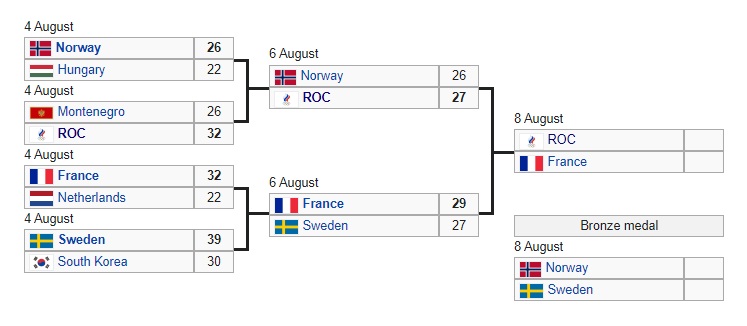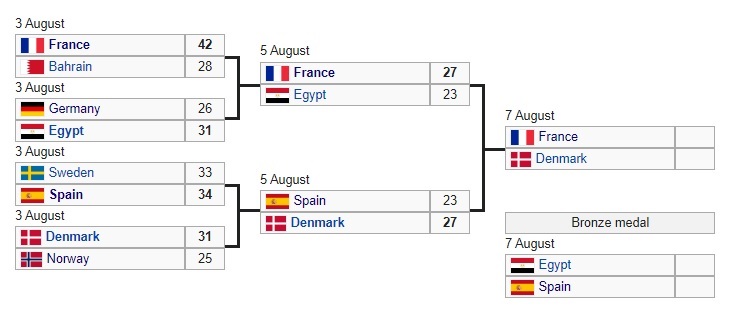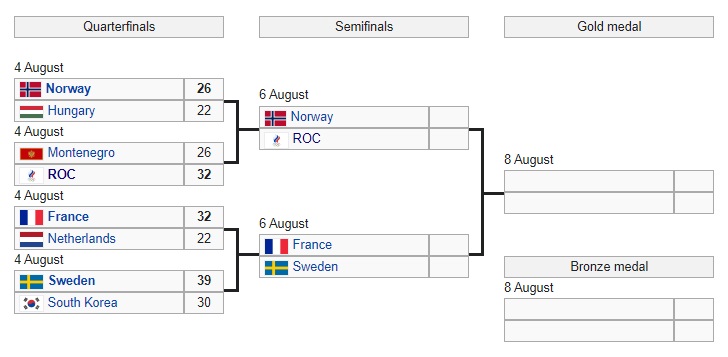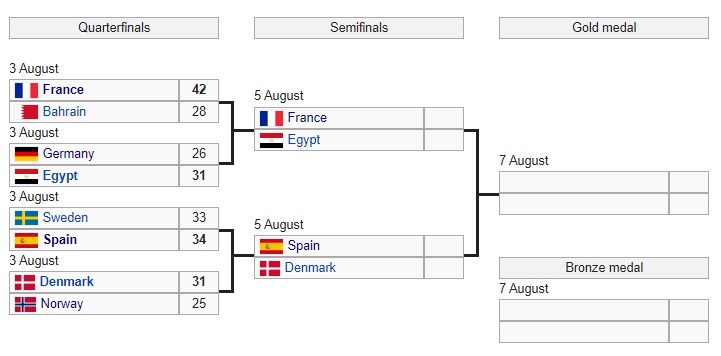- These 2 Semifinal matches will be played in Japan on Sunday, 8 August
- Japan is 7 hours ahead of CET; 13 hours ahead of US ET
- Japan (Local) Match start times: 1100 and 1500
- CET Match start times: 0400 and 0800
- US ET Match start times: 2200 (Saturday) and 0200
- Odds courtesy of Bet MGM and/or OddsPortal
Bracket

- Norway (-4) vs Sweden (Saturday, 2200 US ET; Sunday, 0400 CET; Sunday 1100 Local)
- Broadcast live in the U.S. on CNBC
- Russia (-1) vs France (Sunday, 0200 US ET; Sunday, 0800 CET; Sunday 1500 Local)
- These Men’s Gold and Bronze Medal matches will be played in Japan on Saturday, 7 August
- Japan is 7 hours ahead of CET; 13 hours ahead of US ET
- Japan (Local) Match start times: 1700 and 2100
- CET Match start times: 1000 and 1400
- US ET Match start times: 0400 and 0800
- Odds courtesy of Bet MGM and/or OddsPortal
Bracket

- Egypt vs Spain (-0.5) (Saturday, 0400 US ET; Saturday, 1000 CET; Saturday 1700 Local)
- France vs Denmark(-1.5) (Saturday, 0800 US ET; Saturday, 1400 CET; Saturday 2100 Local)
- These 2 Semifinal matches will be played in Japan on Friday, 6 August
- Japan is 7 hours ahead of CET; 13 hours ahead of US ET
- Japan (Local) Match start times: 1700 and 2100
- CET Match start times: 1000 and 1400
- US ET Match start times: 0400 and 0800
- Odds courtesy of Bet MGM and/or OddsPortal
Bracket

- France (-1) vs Sweden (Friday, 0400 US ET; Friday, 1000 CET; Friday 1700 Local)
- Norway (-2.5) vs Russia (Friday, 0800 US ET; Friday, 1400 CET; Friday 2100 Local)
- These 2 Semifinal matches will be played in Japan on Thursday, 5 August
- Japan is 7 hours ahead of CET; 13 hours ahead of US ET
- Japan (Local) Match start times: 1700 and 2100
- CET Match start times: 1000 and 1400
- US ET Match start times: 0400 and 0800
- Odds courtesy of Bet MGM and/or OddsPortal
Bracket

- France (-1.5) vs Egypt (Thursday, 0400 US ET; Thursday, 1000 CET; Thursday 1700 Local)
- Spain vs Denmark(-2.5) (Thursday, 0745 US ET; Thursday, 1345 CET; Thursday 2045 Local)
- These 4 Quarterfinal matches will be played in Japan on Wednesday, 4 August
- Japan is 7 hours ahead of CET; 13 hours ahead of US ET
- Japan (Local) Match start times: 0930, 1315, 1700 and 2045
- CET Match start times: 0230, 0615, 1000 and 1345
- US ET Match start times: 2030 (day before), 0015, 0400 and 0745
- Odds courtesy of Bet MGM and/or OddsPortal
Bracket

- Montenegro vs Russia (-4) (Tuesday, 2030 US ET; Wednesday, 0230 CET; Wednesday, 0930 Local)
- Norway (-7.5) vs Hungary (Wednesday, 0015 US ET; Wednesday, 0615 CET; Wednesday 1315 Local)
- Sweden (-4) vs S Korea (Wednesday, 0400 US ET; Wednesday, 1000 CET; Wednesday 1700 Local)
- France (-0.5) vs Netherlands (Wednesday, 0745 US ET; Wednesday, 1345 CET; Wednesday 2045 Local)
- These 4 Quarterfinal matches will be played in Japan on Tuesday, 3 August
- Japan is 7 hours ahead of CET; 13 hours ahead of US ET
- Japan (Local) Match start times: 0930, 1315, 1700 and 2045
- CET Match start times: 0230, 0615, 1000 and 1345
- US ET Match start times: 2030 (day before), 0015, 0400 and 0745
- Odds courtesy of Bet MGM and/or OddsPortal
Bracket

- France (-9) vs Bahrain (Monday, 2030 US ET; Tuesday, 0230 CET; Tuesday, 0930 Local)
- Sweden vs Spain (-0.5) (Tuesday, 0015 US ET; Tuesday, 0615 CET; Tuesday 1315 Local)
- Denmark (-2.5) vs Norway (Tuesday, 0400 US ET; Tuesday, 1000 CET; Tuesday 1700 Local)
- Germany (-0.5) vs Egypt (Tuesday, 0745 US ET; Tuesday, 1345 CET; Tuesday 2045 Local)
- These 6 Group Play matches will be played in Japan on Monday, 2 August
- Japan is 7 hours ahead of CET; 13 hours ahead of US ET
- Japan (Local) Match start times: 0900, 1100, 1415, 1615, 1930 and 2130
- CET Match start times: 0200, 0400, 0715, 0915, 1230, 1430
- US ET Match start times: 2000, 2200 (day before); 0115, 0315, 0630, 0830
- Odds courtesy of Bet MGM and/or OddsPortal
- NBC Live Streams Replays
Group A
 Group A Standings Prior to Match Day 5
Group A Standings Prior to Match Day 5 - S Korea (-2.5) vs Angola (Sunday, 2000 US ET; Monday, 0200 CET; Monday, 0900 Local)
- Netherlands (-3) vs Montenegro vs S Korea (Monday, 0630 US ET; Monday, 1230 CET; Monday, 1930 Local)
- Norway (-6.5) vs Japan (Monday, 0830 US ET; Monday, 1430 CET; Monday, 2130 Local)
Group B
 Group B Standings Prior to Match Day 5
Group B Standings Prior to Match Day 5 - France (-3.5) vs Brazil (Sunday, 2200 US ET; Monday, 0400 CET; Monday, 1100 Local)
- Spain vs Russia (-2.5) (Monday, 0115 US ET; Monday, 0715 CET; Monday, 1415 Local)
- Hungary (-1) vs Sweden (Monday, 0315 US ET; Monday, 0915 CET; Monday, 1615 Local)
- These 6 Group Play matches will be played in Japan on Saturday, 31 July
- Japan is 7 hours ahead of CET; 13 hours ahead of US ET
- Japan (Local) Match start times: 0900, 1100, 1415, 1615, 1930 and 2130
- CET Match start times: 0200, 0400, 0715, 0915, 1230, 1430
- US ET Match start times: 2000, 2200 (day before); 0115, 0315, 0630, 0830
- Odds courtesy of Bet MGM and/or OddsPortal
- NBC Live Streams Replays
Group A
 Group A Standings Prior to Match Day 4
Group A Standings Prior to Match Day 4- Angola vs Japan (-1) (Friday, 2000 US ET; Saturday, 0200 CET; Saturday, 0900 Local)
- Montenegro (-1) vs S Korea (Friday, 2200 US ET; Saturday, 0400 CET; Saturday, 1100 Local)
- Norway (-4) vs Netherlands (Saturday, 0830 US ET; Saturday, 1430 CET; Saturday, 2130 Local)
- Rebroadcast in the U.S at 9:45 AM US ET on the NBC Sports Network
Group B
 Group B Standings Prior to Match Day 4
Group B Standings Prior to Match Day 4- Russia vs France (Pick’em) (Saturday, 0115 US ET; Saturday, 0715 CET; Saturday, 1415 Local)
- Brazil vs Sweden (-3.5) (Saturday, 0315 US ET; Saturday, 0915 CET; Saturday, 1615 Local)
- Hungary vs Spain (-2.5) (Saturday, 0630 US ET; Saturday, 1230 CET; Saturday, 1930 Local)
- These 6 Group Play matches will be played in Japan on Friday, 30 July
- Japan is 7 hours ahead of CET; 13 hours ahead of US ET
- Japan (Local) Match start times: 0900, 1100, 1415, 1615, 1930 and 2130
- CET Match start times: 0200, 0400, 0715, 0915, 1230, 1430
- US ET Match start times: 2000, 2200 (day before); 0115, 0315, 0630, 0830
- Odds courtesy of Bet MGM and/or OddsPortal
Group A
 Group A Standings Prior to Match Day 4
Group A Standings Prior to Match Day 4- Argentina vs Brazil (-.5) (Thursday, 2000 US ET; Friday, 0200 CET; Friday, 0900 Local)
- France vs Spain (Pick’em) (Friday, 0115 US ET; Friday, 0715 CET; Friday, 1415 Local)
- Germany vs Norway (-1) (Friday, 0830 US ET; Friday, 1430 CET; Friday, 2130 Local)
Group B
 Group B Standings Prior to Match Day 4
Group B Standings Prior to Match Day 4- Bahrain vs Japan (-1) (Thursday, 2200 US ET; Friday, 0400 CET; Friday, 1100 Local)
- Sweden (-1) vs Egypt (Friday, 0315 US ET; Friday, 0915 CET; Friday, 1615 Local)
- Portugal vs Denmark (-5.5) (Friday, 0630 US ET; Friday, 1230 CET; Friday, 1930 Local)
- These 6 Group Play matches will be played in Japan on Tuesday, 27 July
- Japan is 7 hours ahead of CET; 13 hours ahead of US ET
- Japan (Local) Match start times: 0900, 1100, 1415, 1615, 1930 and 2130
- CET Match start times: 0200, 0400, 0715, 0915, 1230, 1430
- US ET Match start times: 2000, 2200 (day before); 0115, 0315, 0630, 0830
- Odds courtesy of Bet MGM and/or OddsPortal
- NBC Live Streams Replays
Group A
 Group A Standings Prior to Match Day 2
Group A Standings Prior to Match Day 2- Netherlands (-7.5) vs Angola (Wednesday, 2000 US ET; Thursday, 0200 CET; Thursday, 0900 Local)
- Japan vs S Korea (-3) (Thursday, 0115 US ET; Thursday, 0715 CET; Thursday, 1415 Local)
- Montenegro vs Norway (-5.5) (Thursday, 0315 US ET; Thursday, 0915 CET; Thursday, 1615 Local)
- Rebroadcast in the U.S at 11:15 AM US ET on the NBC Sports Network
Group B
 Group B Standings Prior to Match Day 2
Group B Standings Prior to Match Day 2- Spain (-1) vs Brazil (-2.5) (Wednesday, 2200 US ET; Thursday, 0400 CET; Thursday, 1100 Local)
- Hungary vs Russia (-3) (Thursday, 0630 US ET; Thursday, 1230 CET; Thursday, 1930 Local)
- Sweden vs France (-1) (Thursday, 0830 US ET; Thursday, 1430 CET; Thursday, 2130 Local)
- Rebroadcast in the U.S at 2:00 PM US ET on the NBC Sports Network
- These 6 Group Play matches will be played in Japan on Wednesday, 28 July
- Japan is 7 hours ahead of CET; 13 hours ahead of US ET
- Japan (Local) Match start times: 0900, 1100, 1415, 1615, 1930 and 2130
- CET Match start times: 0200, 0400, 0715, 0915, 1230, 1430
- US ET Match start times: 2000, 2200 (day before); 0115, 0315, 0630, 0830
- Odds courtesy of Bet MGM and/or OddsPortal
Group A
 Group A Standings Prior to Match Day 3
Group A Standings Prior to Match Day 3- Norway (-7.5) vs Argentina (Wednesday, 0315 US ET; Wednesday, 0915 CET; Wednesday, 1615 Local)
- Brazil vs Spain (-5.5) (Wednesday, 0630 US ET; Wednesday, 1230 CET; Wednesday, 1930 Local)
- France (-1.5) vs Germany (Wednesday, 0830 US ET; Wednesday, 1430 CET; Wednesday, 2130 Local)
- Rebroadcast in the U.S. on the NBC Sports Network at 1:30 PM US ET
Group B
 Group B Standings Prior to Match Day 3
Group B Standings Prior to Match Day 3- Denmark (-9.5) vs Bahrain (Tuesday, 2000 US ET; Wednesday, 0200 CET; Wednesday, 0900 Local)
- Sweden (-1.5) vs Portugal (Tuesday, 2200 US ET; Wednesday, 0400 CET; Wednesday, 1100 Local)
- Japan vs Egypt (-6) (Wednesday, 0115 US ET; Wednesday, 0715 CET; Wednesday, 1415 Local)
- These 6 Group Play matches will be played in Japan on Tuesday, 27 July
- Japan is 7 hours ahead of CET; 13 hours ahead of US ET
- Japan (Local) Match start times: 0900, 1100, 1415, 1615, 1930 and 2130
- CET Match start times: 0200, 0400, 0715, 0915, 1230, 1430
- US ET Match start times: 2000, 2200 (day before); 0115, 0315, 0630, 0830
- Odds courtesy of Bet MGM and/or OddsPortal
- NBC Live Streams Replays
Group A
 Group A Standings Prior to Match Day 2
Group A Standings Prior to Match Day 2 - Japan vs Montenegro (-7) (Monday, 2000 US ET; Tuesday, 0200 CET; Tuesday, 0900 Local)
- S Korea vs Netherlands (-5.5) (Tuesday, 0315 US ET; Tuesday, 0915 CET; Tuesday, 1615 Local)
- Angola vs Norway (-12.5) (Tuesday, 0630 US ET; Tuesday, 1230 CET; Tuesday, 1930 Local)
Group B
 Group B Standings Prior to Match Day 2
Group B Standings Prior to Match Day 2- Brazil vs Hungary (-2.5) (Monday, 2200 US ET; Tuesday, 0400 CET; Tuesday, 1100 Local)
- Sweden vs Russia (-2.5) (Tuesday, 0115 US ET; Tuesday, 0715 CET; Tuesday, 1415 Local)
- France (-4.5) vs Spain (Tuesday, 0830 US ET; Tuesday, 1430 CET; Tuesday, 2130 Local)
- Rebroadcast in the U.S at 10:00 AM US ET on the NBC Sports Network
- These 6 Group Play matches will be played in Japan on Monday, 26 July
- Japan is 7 hours ahead of CET; 13 hours ahead of US ET
- Japan (Local) Match start times: 0900, 1100, 1415, 1615, 1930 and 2130
- CET Match start times: 0200, 0400, 0715, 0915, 1230, 1430
- US ET Match start times: 2000, 2200 (day before); 0115, 0315, 0630, 0830
- Odds courtesy of Bet MGM and/or OddsPortal
Group A
 Group A Standings Prior to Match Day 2
Group A Standings Prior to Match Day 2- Brazil vs France (-6.5) (Sunday, 2000 US ET; Monday, 0200 CET; Monday, 0900 Local)
- Argentina vs Germany (-6.5) (Sunday, 2200 US ET; Monday, 0400 CET; Monday, 1100 Local)
- Spain vs Norway (Pick’em) (Monday, 0315 US ET; Monday, 0915 CET; Monday, 1615 Local)
- Rebroadcast in the U.S. at 1:45 PM on the NBC Sports Network
Group B
 Group B Standings Prior to Match Day 2
Group B Standings Prior to Match Day 2- Egypt vs Denmark (-4.5) (Monday, 0115 US ET; Monday, 0715 CET; Monday, 1415 Local)
- Rebroadcast in the U.S. at 10:00 AM on the NBC Sports Network
- Bahrain vs Portugal (-4.5) (Monday, 0630 US ET; Monday, 1230 CET; Monday, 1930 Local)
- Japan vs Sweden (-10.5) (Monday, 0830 US ET; Monday, 1430 CET; Monday, 2130 Local)



















